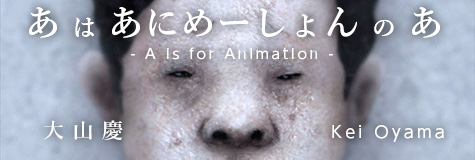
10 One More Time: TECHNE Try
Kei Oyama
In this issue, I would like to present the work Mo Ikkai (One More Time), which was created for NHK's television program TECHNE: Eizo no Kyoshitsu (TECHNE: The Visual Workshop, broadcast in March 2014).
TECHNE is a program that introduces the wide array of technical methods involved in the creation of visual images. It contains a segment called "TECHNE Try," in which artists are challenged to create visual works using the technical method introduced in the episode. The theme assigned to me was rotoscoping. Rotoscoping is the animation technique of tracing over live action video footage to create an animated film.
Capturing live-action video footage is a mechanical process achieved through the use of cameras, so it does not incorporate emotional elements. There are a number of techniques to incorporate emotions, but in principle the footage can record only objects (light) that exist in the physical world.
The world of pictures and animated films, on the other hand, depends entirely on the imagination and skills of the creator. It is a world in which only the things drawn by the artist can exist.
When I was first contacted about this project, I decided to create a work based on the theme of memory by blending the veracity inherent to live action video footage and the subjectivity typical of pictures drawn by the human hand (in other words, by using the rotoscoping technique).
First, take a look at this video. I recommend that you watch it at a high definition setting.
In this technique, the animator prints out, frame by frame, the live action footage of a girl who is walking away from the camera. He then traces over the footage with a pencil on drawing paper.
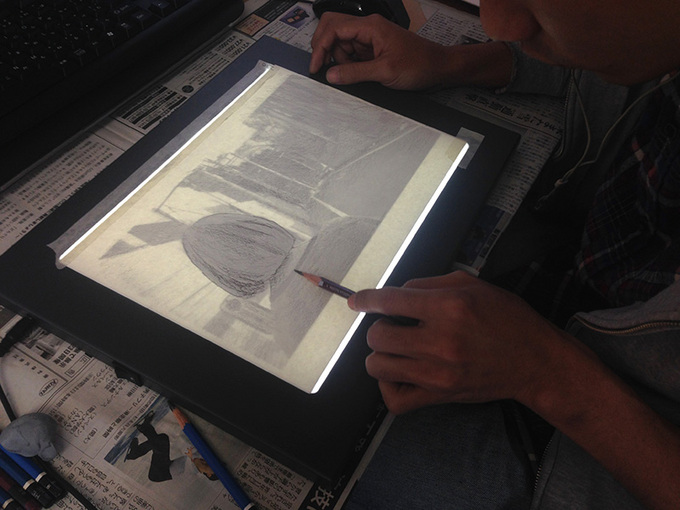 The animator uses only one sheet of drawing paper in this technique. After tracing one frame, he takes a photo of it. He then erases the drawing, traces the second frame, photographs it, erases it, and repeats the process with the next frame. This is why tiny traces of the previous sketch remain on the paper as the process is repeated.
The animator uses only one sheet of drawing paper in this technique. After tracing one frame, he takes a photo of it. He then erases the drawing, traces the second frame, photographs it, erases it, and repeats the process with the next frame. This is why tiny traces of the previous sketch remain on the paper as the process is repeated.
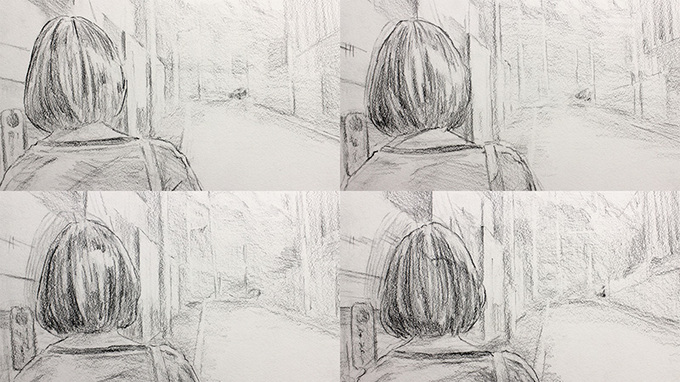 When taking photos of the drawing paper, the animator gradually moves the camera closer to the paper so that the size of the girl always remains the same in relation to the screen.
When taking photos of the drawing paper, the animator gradually moves the camera closer to the paper so that the size of the girl always remains the same in relation to the screen.
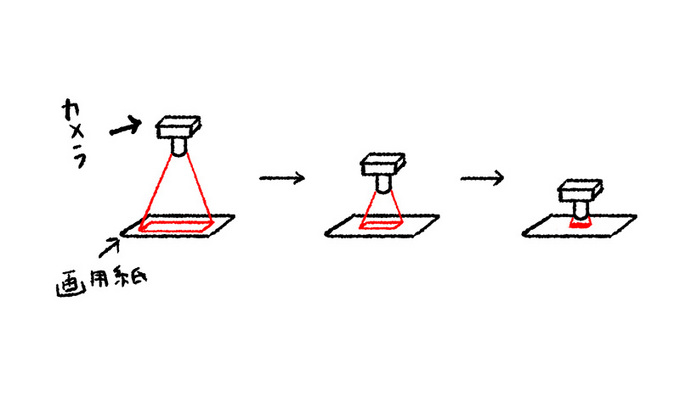 Illustration above:Camera, Illustration below:Drawing paper
Illustration above:Camera, Illustration below:Drawing paper
The animator uses a camera with a special lenses that makes it possible to take close-up photos from a very short distance. As the tracing and erasing process continues, the uneven surface of the paper is gradually revealed and the outline of the girl becomes blurry. Eventually what was represented in the original image is obscured and the texture of the drawing paper becomes visible.
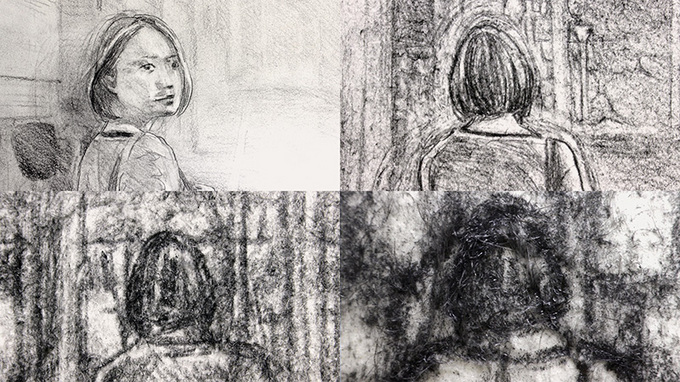 The animator uses this technique to convey the concept of memory. The elusive shapes and lingering outlines of the past cannot be fully erased and live on in the form of stains and scratches on the paper.
The animator uses this technique to convey the concept of memory. The elusive shapes and lingering outlines of the past cannot be fully erased and live on in the form of stains and scratches on the paper.
I engaged Yuta Kuniyasu as the animator for this project. At the time, he had parted ways with his long-term girlfriend and for over a year carried the emotional scars of the breakup. I thought that if anyone could bring this animation to life, it was him.
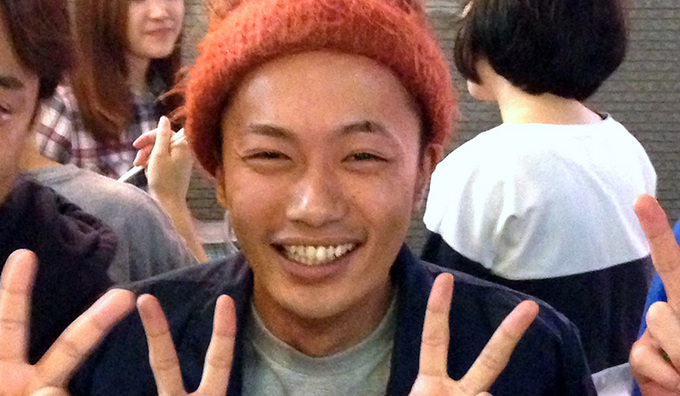
Yuta Kuniyasu
I explained the concept to Kuniyasu, and asked him to trace as if he was drawing a picture. In other words, I asked him to go beyond simply tracing the objects visible in the frame and capture the unseen beauty that he could feel.
As Kuniyasu proceeded with the repetitive process of creating the animation, the memory of his former girlfriend came to him again and again. The production period was relatively short, so he often stayed at the office overnight to work on the project. He forgot my warning that pressing down too hard with the pencil would damage the paper and continued drawing with intense concentration. The result of his efforts to breathe life into the animation greatly surpassed my expectations.
After the visual images were completed, we reached the stage of adding sound to the animation. Here, Kuniyasu and I repeatedly argued over the concept of this work. The project was originally intended to center around the theme of memory, but as the drawing process advanced, it felt as if the component of a man's anguish over a lost love had taken over the animation. We recorded various lines and sounds, tried multiple audio patterns, and eventually I left the final decision to Kuniyasu. As a result, it turned into a very private work, an animation so sentimental that it could make you chuckle.
Although the concept of the finished work differs from the direction we initially considered, I can honestly say that I feel very happy with the result and am glad that we produced this animation. It is a sweet and endearing piece. At the time of its broadcast, the animated film was credited as a jointly directed work, but ultimately we decided that Yuta Kuniyasu was to be recognized as the sole director of the film.
By creating this animation, Kuniyasu managed to break through to a positive state of mind. If any of you reading this article should experience heartbreak, I would recommend sketching hundreds or even thousands of pictures onto drawing paper. By recording the process, you will be left with a splendid piece of animation!
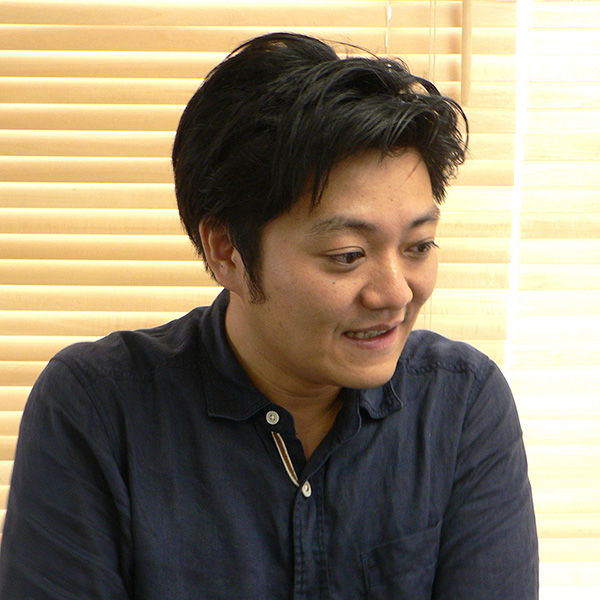 Kei Oyama
Kei Oyama
Animation artist. Born in Tokyo in 1978.
In 2005, Shinsatsushitsu (Consultation Room), his graduation project at Tokyo Zokei University, won the Gold Prize for the Campus Genius Award, as well as Best Picture for BACA-JA. Oyama has been formally invited to international film festivals such as the Directors' Fortnight of the Cannes International Film Festival. In 2008 he made HAND SOAP for Aichi Arts Center which won him many awards including the Grand Prix for the Holland Animation Film Festival and the Special Prize for the International Animation Festival Hiroshima. In the live motion movies Watashi wa neko sutoka (I'm a cat stalker, 2008) and Gegege no nyobo (Gegege's wife, 2010) Oyama was in charge of making the animation clips. He is now a member of CALF which he founded with his partners, making Hokago (After School) while producing, distributing, and selling animation works.
Official website: http://www.keioyama.com/
CALF : http://calf.jp/
CALF STUDIO : http://calf.jp/studio/
Back Issues
- 2022.7.27 Beyond Disasters - T…
- 2022.6.20 Beyond Disasters - T…
- 2021.6. 7 Contributed Article …
- 2021.4.28 Crossing Borders, En…
- 2021.4.27 Contributed Article …
- 2021.4.20 Contributed Article …
- 2021.3.29 Contributed Article …
- 2020.12.22 Interview with the R…
- 2020.12.21 Interview with the R…
- 2020.11.13 Interview with the R…

